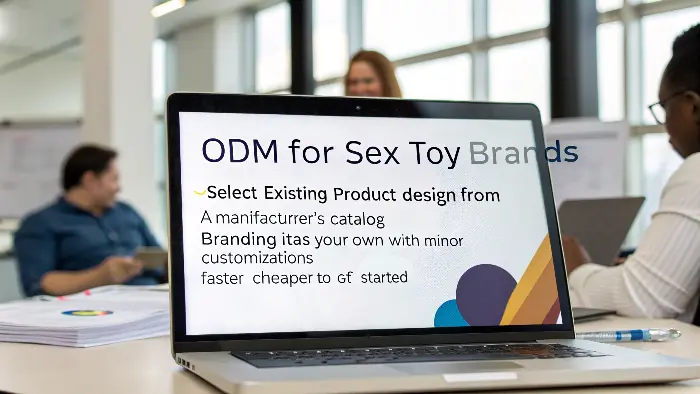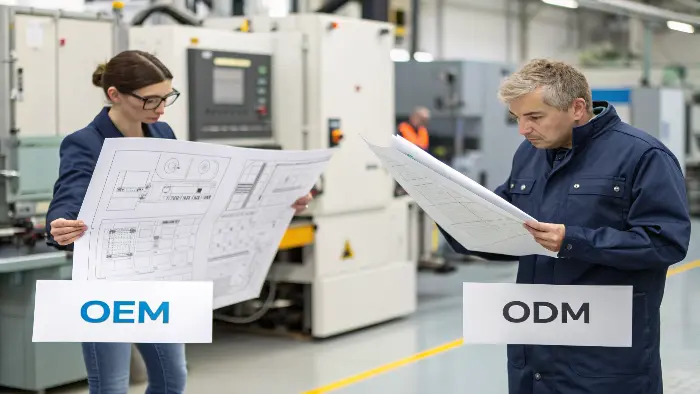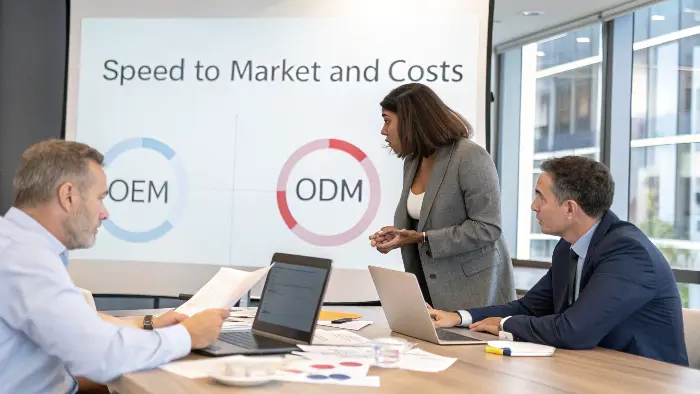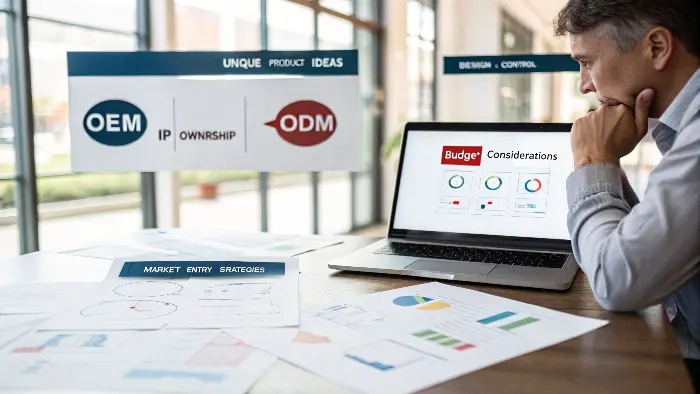Confused about OEM vs ODM for your adult toy line? Choosing wrong can cost time, money, and brand control. This guide clarifies, helping you pick wisely.
OEM (Original Equipment Manufacturer) means you design the adult toy and we, the factory, build it to your specs. ODM (Original Design Manufacturer) is where we design and make products, and you rebrand them. Understanding this difference is key to your success.
Alright, so you’re looking to bring an adult product to market, or maybe expand your existing line. One of the first big questions you’ll hit is: OEM or ODM? I’ve been in the manufacturing game for years, running PrivyPlay, and I’ve seen brand owners thrive – and sometimes stumble – based on this decision. It’s not just alphabet soup; these models are fundamentally different ways to create your products. Making the right choice can really set you up for success, while the wrong one… well, let’s just say it can lead to some headaches. I want to walk you through what each means, the good, the bad, and how to figure out which is the best fit for your brand. Let’s dive in!
What Exactly is OEM in the Adult Toy World, and When Does It Make Sense?
Heard the term OEM thrown around and wondered what it really means for your unique product idea? It’s about bringing your vision to life, but you need the right partner.
OEM means you provide the complete design and specifications for your adult toy. The manufacturer, like PrivyPlay, then produces it exclusively for your brand. It’s great for unique, custom products where you own the design.
So, OEM – Original Equipment Manufacturer. Think of it like this: you’re the architect with a very specific blueprint for a groundbreaking new vibrator, a unique pleasure device, something the world hasn’t seen before. You’ve got the design, the materials picked out, maybe even a prototype. With OEM, you bring that detailed design to a manufacturer like us at PrivyPlay. Our job is then to take your exact specifications and manufacture that product for you, and only for you. It’s your baby, your intellectual property (IP). We just bring it into the physical world.
This model is fantastic if you have a strong, unique product concept and the resources (time, expertise, budget) to develop it.
Key Advantages of OEM:
- Full Design Control: This is the big one. Every curve, every feature, every material is your call. Your product will be truly unique to your brand.
- IP Ownership: The design belongs to you. This is huge for building brand value and differentiation.
- Exclusivity: The manufacturer produces it only for you, so you won’t see your exact product popping up under a competitor’s label.
Potential Downsides:
- Higher Upfront Investment: Design, prototyping, and tooling (molds, etc.) can be expensive and time-consuming. I’ve seen development for a really innovative toy take months, sometimes over a year, before it’s ready for mass production.
- Longer Time to Market: Because you’re starting from scratch, it naturally takes longer to get your product onto shelves.
- Requires Technical Expertise: You or your team need a good understanding of product design and engineering to create effective specifications.
For brand owners who are passionate about innovation and want to build a truly distinct product line, OEM is often the way to go. We’ve worked with some amazing entrepreneurs at PrivyPlay who came to us with incredible ideas, and seeing those come to life through an OEM partnership is incredibly rewarding. It’s perfect if you’re saying, "I have this amazing idea, and no one else is doing it!"And What About ODM? How Does That Work for Sex Toy Brands?
Perhaps you want quality products faster, without designing from scratch? ODM might be your ticket. It’s about leveraging existing designs to build your brand quickly. Let’s see how.
ODM means you select an existing product design from a manufacturer’s catalog. You then brand it as your own, often with minor customizations. It’s faster and usually cheaper to get started.

Now, let’s switch gears to ODM – Original Design Manufacturer. This is a very different beast. Imagine walking into a showroom (or, more likely these days, browsing an online catalog like PrivyPlay’s) filled with a variety of pre-designed adult toys. With ODM, the manufacturer has already done the heavy lifting of designing, engineering, and often even tooling for these products. You, as the brand owner, select a product that fits your brand’s aesthetic and target market. Then, you essentially put your label on it. It’s sometimes called "white-labeling" or "private labeling."
You might be able to request some minor modifications – think color changes, different packaging, maybe a slight tweak to a feature if the manufacturer is open to it and it’s not too complex. But the core design remains the manufacturer’s.
Key Advantages of ODM:
- Faster Time to Market: This is a huge plus. Since the product is already designed and often production-ready, you can get it to market much quicker than with OEM. I’ve seen brands go from selection to having products in hand in a matter of weeks, not months or years.
- Lower Upfront Costs: No need to invest heavily in R&D, design, or expensive custom molds. The manufacturer has already absorbed these costs. This means a lower barrier to entry.
- Proven Designs: Often, these are products that have already been tested or even sold in other markets, so there’s less risk of design flaws.
Potential Downsides:
- Limited Customization: You’re working with an existing design, so your ability to make it truly unique is limited. Your product might look very similar to competitors who source from the same ODM catalog.
- No IP Ownership (Usually): The design IP generally stays with the manufacturer. You’re essentially licensing the design for your brand.
- Less Brand Differentiation: It can be harder to stand out if your core product isn’t exclusive.
ODM is a fantastic option for brands looking to get started quickly, test the market, or expand their range with proven sellers without a massive R&D spend. Many successful brands use ODM products, especially for more standard items in their lineup. At PrivyPlay, we offer a wide range of ODM products because we know many of our clients value speed and cost-effectiveness, especially when they’re just starting or want to add complementary items to their unique OEM offerings.OEM vs. ODM: Which Path Offers More Control Over My Product Design?
Want your product to be exactly how you envision it, down to the last detail? Or are you okay with less say for a faster launch? Design control is a biggie.
OEM offers virtually total control over product design, as you provide the specifications. ODM offers very limited design control, usually restricted to branding and minor cosmetic changes on pre-existing designs.

This is a really important question, and for many brand owners I talk to, it’s often the deciding factor. The level of control you have over your product’s design is starkly different between OEM and ODM.
With OEM, you’re in the driver’s seat.
- Total Customization: You dictate the shape, size, materials, features, functionality, technology – everything. If you want a specific type of silicone, a unique motor, a particular button placement, or an innovative new feature, you specify it.
- Unique Identity: Your product will be a true reflection of your brand’s vision and values. It won’t be a "me-too" product. I remember working with a client who had a very specific ergonomic design in mind for a wand massager, something that required completely new molds. That’s classic OEM – they had full control to realize their vision.
The trade-off, of course, is that all this control comes with responsibility. You need to have that clear vision and be able to translate it into detailed technical specifications. If the design has flaws, well, those are your flaws.
With ODM, your control is much more limited. - Pre-Set Designs: You’re choosing from the manufacturer’s existing catalog. The core design is already fixed.
- Minor Modifications (Sometimes): You can usually change colors, apply your logo, and design your own packaging. Some ODM suppliers, like us at PrivyPlay, might offer slight modifications to existing designs if the order volume is significant enough – maybe a different texture or a small feature adjustment. But you’re not reinventing the wheel.
- Focus on Branding: Your main way to differentiate is through your brand story, marketing, packaging, and customer service, rather than the core product design itself.
So, if having a product that is 100% unique and tailored to your exact vision is paramount, OEM is the clear winner. You get to call all the shots on design. If you’re more focused on getting a quality product to market quickly and are comfortable with a more standard design that you can brand effectively, then the limited design control of ODM might be perfectly acceptable, even preferable, given the other benefits like speed and lower cost.Speed to Market and Costs: How Do OEM and ODM Stack Up?
Need to launch ASAP, or is a longer, more custom development timeline feasible? And what about the budget? These practicalities heavily influence the OEM vs. ODM decision.
ODM is significantly faster to market and has lower upfront costs because designs are pre-existing. OEM involves longer development times and higher initial investments due to custom design, prototyping, and tooling.

Let’s talk about two very practical considerations: how fast can you get your product out there, and how much is it going to cost you upfront? These are often make-or-break factors for many businesses, especially startups or smaller brands.
When it comes to Speed to Market:
- ODM Wins Big: With ODM, you’re essentially picking a product off the shelf. The design is done, tooling often exists, and the manufacturer might even have components in stock or established supply chains. This means you can go from selecting a product to having it ready to ship in a relatively short timeframe – sometimes a few weeks to a couple of months, depending on customization and production capacity. I’ve seen PrivyPlay clients using our ODM services get their branded products ready for a trade show with a surprisingly quick turnaround.
- OEM Takes Time: Creating a unique product from scratch is a journey. It involves:
- Concept and detailed design
- Prototyping (often multiple iterations)
- Tooling (creating molds, which can take weeks or months and be quite costly)
- Testing and refinement
- Setting up the production line
This entire process can easily take 6 months to a year, or even longer for highly complex products. There’s no real shortcut if you want a truly custom item.
And for Upfront Costs:
- ODM is More Affordable: Because the manufacturer has already invested in the R&D, design, and tooling for their catalog products, you don’t bear these costs directly. Your main upfront expenses will be the per-unit cost of the goods, your custom packaging, and potentially a smaller setup fee for branding. This makes ODM very attractive for businesses with limited capital.
- OEM Requires Significant Investment: You’re funding the entire development process. This includes:
- Design fees (if you hire designers)
- Prototyping costs
- Tooling/Mold making (this can be thousands, even tens of thousands of dollars, depending on complexity)
- Minimum Order Quantities (MOQs) for custom components might also be higher.
While the per-unit cost might eventually be lower with OEM if you have huge volumes, the initial cash outlay is undeniably much larger.
So, if your priority is a rapid launch and managing cash flow carefully, ODM has a clear advantage. If you have a longer-term vision for a unique product and the budget to support its development, OEM becomes a viable and often preferred route.Protecting My Brand and Ideas: What are the IP Risks with OEM and ODM?
You’ve got a killer idea or a strong brand. How do you keep it safe when working with manufacturers? Intellectual Property is a tricky area, let’s navigate it.
With OEM, you generally own the Intellectual Property (IP) for your unique design. With ODM, the IP for the product design usually stays with the manufacturer. Strong contracts are vital in both cases to protect your brand.

Intellectual Property (IP) – this is a big one, especially in a creative and competitive industry like adult products. Protecting your designs, your brand, and your innovations is crucial. The way IP is handled differs significantly between OEM and ODM models.
OEM and Your IP:
When you go the OEM route, you are bringing your design to the manufacturer.
- You Own the Design: Typically, the design, the schematics, the unique features – all that IP belongs to you, the brand owner. This is a major advantage of OEM. You’re creating a unique asset for your company.
- Protecting Your IP: It’s absolutely critical to have strong contracts in place. This means clear Non-Disclosure Agreements (NDAs) before you even show your detailed designs, and a comprehensive manufacturing agreement that explicitly states your ownership of the IP and prevents the manufacturer from using or selling your design to anyone else. At PrivyPlay, we take client IP very seriously and always operate under strict confidentiality.
- Risk: The main risk is if your manufacturer isn’t trustworthy and tries to copy your design or sell it to others. This is why choosing a reputable, established manufacturer is so important. Always do your due diligence!
ODM and IP (or lack thereof for your brand):
With ODM, the situation is quite different. - Manufacturer Owns the Design IP: The manufacturer developed the product, so they own the core design IP. You are essentially licensing the right to use that design under your brand.
- What You Own: You own your branding (logo, brand name, packaging design), but not the product itself.
- Risk of Copycats (sort of): The "risk" here isn’t that the manufacturer will steal your design, because it’s not yours to begin with. The risk is that other brands can (and likely will) license the exact same or very similar product from the same ODM manufacturer and sell it under their own brand. This is why differentiation through branding, marketing, and customer experience is so vital with ODM.
- Customizations: If you pay for significant non-trivial modifications to an ODM product, you might be able to negotiate some IP ownership over those specific modifications, but this needs to be clearly defined in your contract. It’s a bit of a gray area and less common.
Regardless of the model, clear, legally sound contracts are your best friend. For OEM, it’s about protecting your unique creation. For ODM, it’s about understanding the terms of use and focusing on building your brand around a product you don’t exclusively own.Making the Choice: How Do I Decide if OEM or ODM is Right for My Adult Product Business?
Feeling pulled in two directions? It’s a big decision! Let’s break down the key factors to help you choose the manufacturing path that aligns best with your brand’s goals.
Choose OEM if you have a unique product idea, prioritize design control and IP ownership, and have the budget/time for development. Opt for ODM for faster market entry, lower upfront costs, and if you’re okay with standard designs.

Okay, we’ve covered a lot of ground. So, how do you actually decide which path is the right one for your adult product business? It really boils down to your specific goals, resources, and priorities. There’s no single "best" answer; it’s about what’s best for you.
I often advise clients at PrivyPlay to consider these key questions:
- Do you have a truly unique product idea?
- Yes, and it’s critical to my brand: Lean towards OEM. You need the design control and IP ownership.
- No, I’m looking for quality products to build my brand around: ODM could be a great fit.
- How important is exclusivity and differentiation through product design?
- Very important, I want something no one else has: OEM.
- Less important, I can differentiate through branding, marketing, and service: ODM is viable.
- What’s your budget for product development and initial inventory?
- I have capital for R&D, design, and tooling: OEM is an option.
- I need to minimize upfront costs and manage cash flow tightly: ODM is likely more suitable.
- How quickly do you need to get to market?
- I have time for a thorough development process: OEM.
- Speed is a top priority: ODM offers a much faster route.
- What’s your team’s technical expertise in product design and engineering?
- We have strong in-house or contracted expertise: OEM is manageable.
-
We have limited technical resources for design: ODM simplifies this, as the manufacturer handles design.
Here’s a simple table to help visualize:Feature OEM (Original Equipment Manufacturer) ODM (Original Design Manufacturer) Product Design Your unique design & specifications Manufacturer’s existing design IP Ownership You own the design IP Manufacturer owns design IP Customization High (total control) Low (branding, minor tweaks) Upfront Costs High (R&D, tooling) Low (minimal R&D/tooling costs) Time to Market Long (6+ months) Short (weeks to few months) Differentiation High (unique product) Lower (product potentially common) Best For Brands wanting unique, innovative products, with resources for development Brands wanting fast launch, lower risk, or standard product lines Sometimes, a hybrid approach can even work. Maybe you develop one or two flagship products via OEM and supplement your range with some ODM items to broaden your catalog quickly.
Ultimately, the choice depends on your business strategy. Think carefully about these factors, and don’t hesitate to discuss your needs with potential manufacturing partners. A good partner, whether for OEM or ODM, will help guide you. That’s certainly what we aim to do at PrivyPlay. We want to see your brand succeed, whichever path you choose!Conclusion
Choosing between OEM and ODM is pivotal. OEM offers design control and IP for unique products, while ODM provides speed and lower costs with existing designs. Align your choice with your brand vision, resources, and market goals.
